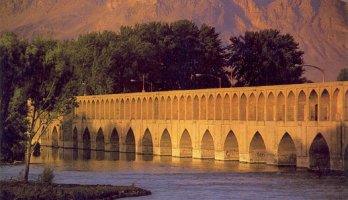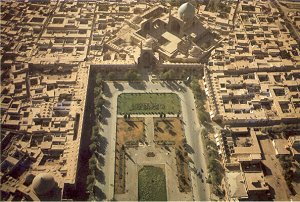|
Historical Cities of Iran
Si-o-se-pol or
"Allah-verdi Khan Bridge", The vast province of Isfahan, is located almost in the centre of Iran between Tehran and Fars. Although it is mostly arid, there are several high mountains (Mount. Karkas at 3899m) and rivers such as the Zayandeh Rud 1 that dominate its landscape. A large population lives in the numerous oases that mark the old caravan routes, which linked not only the northwest and southwest of Iran, but crossed the mountain cols to the south, towards Shiraz and the ports on the Persian Gulf. On approaching the city of Isfahan, leaving behind the great deserts bounded by the mountain chains that enclose the Iranian plateau, one comes upon a wide basin at the bottom of which sleeps the historical city. The most striking thing, at first site, is the contrast between the endless expanse of rock and sand behind, and the huge oasis that lies ahead, with its big trees bearing lush, verdant foliage. Only the bulbous domes of the Mosques show above the canopy of vegetation glowing turquoise-green in the sunshine. The cool blue tiles of Isfahan’s Islamic buildings, and the cities majestic bridges, contrast perfectly with the hot dry Iranian countryside around it. The main monuments of Isfahan are essentially the work of one man; Shah Abbas I (more commonly known as Shah Abbas the Great), who made the town his capital in 1598, and had it rebuilt with large avenues, magnificent gardens and a royal palace. Shah Abbas chose Isfahan as his capital, prompted by the fear for the safety of the old capitals, Tabriz and Qazvin, which were considered too close to the Ottoman Empire. During his reign, Isfahan was opened up to the outside world with the presence of a number of foreigners at the Safavid court - English and Dutch merchants, European artists, and diplomats hoping to secure alliances against the common Ottoman enemy - and became one of the most glorious cities of its time. The famous half rhyme "Isfahan nesf-eh jahan" (Isfahan is half the world) was coined in 16th century to express the city’s grandeur. However, its period of glory lasted, for little more than 100 years. An invasion by the Afghans in the 18th Century, hastened the decline and the capital was subsequently transferred to Shiraz and then to Tehran. *** Isfahan’s main monuments are centred around the following areas; the Imam Square (or Royal Square), the Friday Mosque, and the bridges on the Zayandeh Rud. The centre of Isfahan during the Seljuk period was the Friday Mosque. Today, the mosque is like a patchwork of history with a winter hall that is probably Timurid; minarets built by the "Black Sheep" tribe and the interior decorated by the Safavids. In 1598, Shah Abbas decided to shift this centre to the present day Imam Square - according to some, in order to annoy a rich merchant who was reluctant to part with his property.
"Aerial view of
Imam Square" This Square is one of the largest in the world (500m x 160m) and was the symbolic centre of the Safavid Dynasty and its Empire. It was used for holding festivals, markets and games of polo. The original goal posts from Shah Abbas’ polo grounds are still in place today at the far ends of the square. The square is surrounded on all four sides by long walls with the Imam Mosque in the south, the Mosque of Sheikh Lotfollah in the east, the Ali Qapu Palace in the west and the entrance of the great Bazaar in the north. It is a very popular spot on summer evenings when the Isfahanis settle down on carpets and bring out their picnics and samovars. Isfahan’s majestic buildings and bridges, elegant gardens, attractive bazaars and teahouses, entrance the visitor into wanting to spend as much time as possible in its relaxing atmosphere.
1) Rud is the Persian for River
Copyright shall at all times remain vested in the Author. No part of the work shall be used, reproduced, stored in a retrieval system, or transmitted in any form or by any means electronic, mechanical, photocopying, recording or otherwise, without the Author's express written consent. Copyright © 1998 K. Kianush, Art Arena |

